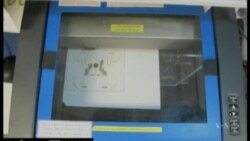Origami can turn a flat sheet of paper into complex 3-D shapes like birds and flowers and frogs. Scientists at Harvard University's Microrobotics Lab are taking the art of paper folding to a new dimension with origami inspired designs that robots can follow to assemble themselves.
Graduate student Sam Felton's latest project is a six-legged creature with a body about 18 cm wide and 15 cm long that looks like a tiny crab. He explains that the goal was to make robots as quickly and cheaply as possible.
"And so we looked to origami in order to find ways to create a very complex and functional machine. Mathematically, origami can create almost anything you want. But the trick is to actually get it to happen in real life with real materials.”
To make that happen, Felton starts with shape memory polymers. These are flat plastic sheets that change shape in response to heat.They combine that with other materials, including paper, which provides extra stiffness and stability as the process unfolds.
Electronics embedded between the layers are programmed to kick the folding action into gear, triggered by an on-board battery.
Felton explained, “we supplied these with current, much like you would supply a light bulb with current, and that heats up that local area to above 100 degrees Celsius. Once it hits 100 degrees Celsius, the shape memory polymers shrink and that pulls on the paper causing it to fold over.”
The operation starts within ten seconds
“And as soon as that brain is told to start running, it goes through the process of telling each circuit to turn on or off and once it knows it’s assembled, it tells the robot to walk forward.”
The whole process takes four minutes.
This is the first time that the robot is doing everything on its own, Felton says.
“What we’ve shown here is that you can embed all these systems onto an autonomous robot and cause it to control its own folding. In previous examples there has always been an operator behind to flip the switch to supply the electricity. In this case it’s flipping its own switch.”
Writing in the journal Science, Felton says the process allows researchers to quickly produce complex robots that are scalable to different sizes and strong for their weight. The ability to be shipped flat in large quantities makes them especially valuable.
Felton sees applications for the self-assembling robots in confined spaces, such as collapsed building, where they could be used in search and rescue missions. He also sees possibilities in outer space.
“I like to think about assembling in space. If you could send a ream of flat sheets up, that then turn themselves into satellites or even send that ream to another planet and have it turn itself into a new base.”
Here's a video showing the robot at work:








